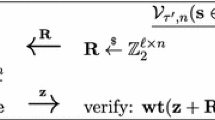Abstract
In this paper, we present three algebraic constructions of authentication codes with secrecy. The first and the third class are optimal. Some of the codes in the second class are optimal, and others in the second class are asymptotically optimal. All authentication codes in the three classes provide perfect secrecy.
Similar content being viewed by others
References
E. F. Brickel, A few results in message authentication, Congressus Numerantium, Vol. 43 (1984) pp. 141–154.
L. R. A. Casse, K. M. Martin and P. R. Wild, Bounds and characterizations of authentication/ secrecy schemes, Designs, Codes and Cryptography, Vol. 13 (1998) pp. 107–129.
S. Chanson, C. Ding and A. Salomaa, Cartesian authentication codes from functions with optimal nonlinearity, Theoretical Computer Science, Vol. 290 (2003) pp. 1737–1752.
M. De Soete, Some constructions for authentication-secrecy codes, Advances in Cryptology: Eurocrypt' 88, Lecture Notes in Computer Science, Springer-Verlag, New York, Vol. 330 (1988) pp. 57–76.
E. Gilbert, F. J. MacWilliams and N. J. A. Sloane, Codes which detect deception, Bell Systems Tech. J., Vol. 53 (1974) pp. 405–424.
J. L. Massey, Cryptography-A Selective Survey, Digital Communications, North-Holland (1986) pp. 3–21.
C. Mitchell, M. Walker and P. Wild, The combinatorics of perfect authentication schemes, SIAM J. Disc. Math., Vol. 7 (1994) pp. 102–107.
D. Pei, Information-theoretic bounds for authentication codes and block designs, J. Cryptology, Vol. 8 (1995) pp. 177–188.
R. S. Rees and D. R. Stinson, Combinatorial characterizations of authentication codes, Designs, Codes and Cryptography, Vol. 7 (1996) pp. 239–259.
U. Rosenbaum, A lower bound on authentication after having observed a sequence of messages, J. Cryptology, Vol. 6 (1993) pp. 135–156.
R. Safavi-Naini and L. Tombak, Authentication codes in plaintext and chosen-content attacks, Advances in Cryptology: Eurocrypt' 94, Lecture Notes in Computer Science, Vol. 950 (1995) pp. 254–265.
A. Sgarro, Information-theoretic bounds for authentication frauds, J. Computer Security, Vol. 2 (1993) pp. 53–63.
C. E. Shannon, Communication theory of secrecy systems, Bell System Tech. J., Vol. 28 (1949) pp. 656–715.
G. J. Simmons, Authentication theory/coding theory, Advances in Cryptology: Crypto' 84, Lecture Notes in Computer Science, Vol. 196 (1984) pp. 411–431.
D. R. Stinson, A construction for authentication/secrecy codes from certain combinatorial designs, J. Cryptology, Vol. 1 (1988) pp. 119–127.
D. R. Stinson and L. Teirlinck, A construction for authentication/secrecy codes from 3-homogeneous permutation groups, European J. Combin., Vol. 11 (1990) pp. 73–79.
T. van Trung, On the construction of authentication and secrecy codes, Designs, Codes and Cryptography, Vol. 5 (1995) pp. 269–280.
Rights and permissions
About this article
Cite this article
Ding, C., Tian, X. Three Constructions of Authentication Codes with Perfect Secrecy. Designs, Codes and Cryptography 33, 227–239 (2004). https://doi.org/10.1023/B:DESI.0000036248.82691.11
Issue Date:
DOI: https://doi.org/10.1023/B:DESI.0000036248.82691.11




